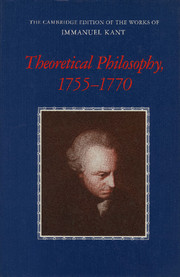Book contents
- Frontmatter
- Contents
- General editors' preface
- Preface
- Guide to abbreviations
- General introduction
- Introductions to the translations
- Résumés of the works
- A NEW ELUCIDATION OF THE FIRST PRINCIPLES OF METAPHYSICAL COGNITION (1755)
- THE EMPLOYMENT IN NATURAL PHILOSOPHY OF METAPHYSICS COMBINED WITH GEOMETRY, OF WHICH SAMPLE I CONTAINS THE PHYSICAL MONADOLOGY (1756)
- AN ATTEMPT AT SOME REFLECTIONS ON OPTIMISM (1759)
- THE FALSE SUBTLETY OF THE FOUR SYLLOGISTIC FIGURES (1762)
- THE ONLY POSSIBLE ARGUMENT IN SUPPORT OF A DEMONSTRATION OF THE EXISTENCE OF GOD (1763)
- ATTEMPT TO INTRODUCE THE CONCEPT OF NEGATIVE MAGNITUDES INTO PHILOSOPHY (1763)
- INQUIRY CONCERNING THE DISTINCTNESS OF THE PRINCIPLES OF NATURAL THEOLOGY AND MORALITY (1764)
- M. IMMANUEL KANT'S ANNOUNCEMENT OF THE PROGRAMME OF HIS LECTURES FOR THE WINTER SEMESTER 1765 — 1766 (1765)
- DREAMS OF A SPIRIT-SEER ELUCIDATED BY DREAMS OF METAPHYSICS (1766)
- CONCERNING THE ULTIMATE GROUND OF THE DIFFERENTIATION OF DIRECTIONS IN SPACE (1768)
- ON THE FORM AND PRINCIPLES OF THE SENSIBLE AND THE INTELLIGIBLE WORLD [INAUGURAL DISSERTATION] (1770)
- Factual notes
- Bibliographies of editions and translations
- Glossary
- Biographical-bibliographical sketches of persons mentioned by Kant
- Index
Introductions to the translations
Published online by Cambridge University Press: 18 December 2014
- Frontmatter
- Contents
- General editors' preface
- Preface
- Guide to abbreviations
- General introduction
- Introductions to the translations
- Résumés of the works
- A NEW ELUCIDATION OF THE FIRST PRINCIPLES OF METAPHYSICAL COGNITION (1755)
- THE EMPLOYMENT IN NATURAL PHILOSOPHY OF METAPHYSICS COMBINED WITH GEOMETRY, OF WHICH SAMPLE I CONTAINS THE PHYSICAL MONADOLOGY (1756)
- AN ATTEMPT AT SOME REFLECTIONS ON OPTIMISM (1759)
- THE FALSE SUBTLETY OF THE FOUR SYLLOGISTIC FIGURES (1762)
- THE ONLY POSSIBLE ARGUMENT IN SUPPORT OF A DEMONSTRATION OF THE EXISTENCE OF GOD (1763)
- ATTEMPT TO INTRODUCE THE CONCEPT OF NEGATIVE MAGNITUDES INTO PHILOSOPHY (1763)
- INQUIRY CONCERNING THE DISTINCTNESS OF THE PRINCIPLES OF NATURAL THEOLOGY AND MORALITY (1764)
- M. IMMANUEL KANT'S ANNOUNCEMENT OF THE PROGRAMME OF HIS LECTURES FOR THE WINTER SEMESTER 1765 — 1766 (1765)
- DREAMS OF A SPIRIT-SEER ELUCIDATED BY DREAMS OF METAPHYSICS (1766)
- CONCERNING THE ULTIMATE GROUND OF THE DIFFERENTIATION OF DIRECTIONS IN SPACE (1768)
- ON THE FORM AND PRINCIPLES OF THE SENSIBLE AND THE INTELLIGIBLE WORLD [INAUGURAL DISSERTATION] (1770)
- Factual notes
- Bibliographies of editions and translations
- Glossary
- Biographical-bibliographical sketches of persons mentioned by Kant
- Index
Summary
NEW ELUCIDATION
Although Kant's New Elucidation (1755) was his first purely philosophical work, he had already published two major and three minor scientific works. Almost a decade earlier, the twenty-two-year-old Kant, having completed a six-year period of study at the University of Königsberg (devoted in part to the humanities and in part, under the influence of Martin Knutzen, to mathematics and natural science), crowned his studies with Living Forces (1747) (AK 1:1–181). Kant had addressed himself to the problem of calculating the magnitude of physical forces, attempting to mediate between and, indeed, reconcile the solution offered by Descartes, who construed force as the product of mass multiplied by velocity (mv), and that of Leibniz, who construed force as the product of mass multiplied by velocity squared (mv2), arguing that Leibniz's account related to ‘living’ force whereas that of Descartes related to ‘dead’ force. The correct account of the matter had been established by Boscovich in 1745, and the correct mathematical formula (mv2/2) was to be published by D'Alembert in the 1758 edition of his Traité de dynamique. In spite of its serious scientific shortcomings, the work displays extraordinary flashes of philosophical genius (the discussion of the structure of space and of the possibility of non-Euclidean spaces [AK 1:23–5] is an example). Living Forces also strikingly displays features characteristic of Kant's later thought: the predilection for a challenge posed by two cogently argued but incompatible positions; the wish to mediate between and, indeed, reconcile the seemingly irreconcilable by construing the two opposed positions as symptoms of a deeper ground of agreement; and the preoccupation with questions of method and epistemology and, in particular, with the issue of the limits of the applicability of mathematics to nature and physics.
In 1746, Kant was obliged temporarily to abandon his university career – the interruption was to last some eight years – by taking employment as a private tutor in the Königsberg area.
- Type
- Chapter
- Information
- Theoretical Philosophy, 1755–1770 , pp. xlix - lxxivPublisher: Cambridge University PressPrint publication year: 1992



